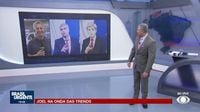In a world increasingly influenced by artificial intelligence, a new trend has emerged on social media, capturing the imagination of users: creating collectible doll versions from personal photos. This phenomenon, which gained momentum following the recent update of ChatGPT, has sparked curiosity and excitement among users eager to see their likenesses transformed into unique toy figures.
Published on April 8, 2025, at 15h42, with the last update later that day, the trend has quickly become a talking point across various platforms. The update to ChatGPT introduced significant enhancements in image creation capabilities, enabling users to turn their photos into personalized collectible dolls. Unlike previous trends, such as recreating images in the style of Studio Ghibli, this new process requires more detailed input from users.
To create a collectible doll, users must provide a photo of the individual they want to transform. However, it doesn’t stop there. The process also involves specifying various features and accessories that the doll should have. Users can even guide ChatGPT on how the packaging of the toy should look, choose a name for it, and customize other aspects to ensure their doll is truly one-of-a-kind.
To access this exciting function, users need to subscribe to the paid version of ChatGPT. While this may deter some, those willing to invest in the service can look forward to a unique experience. However, users should be prepared for potentially longer generation times as the system processes the detailed requests.
In a demonstration of this new feature, a prompt was tested to create a doll of reporter Mateus Omena. The prompt included specific details such as a beige box design, accessories including a notebook, a book, and a travel bag, and the name "Action Figure Mateus Omena" prominently displayed. This level of customization reflects the growing demand for personalized products in an age where individuality is highly valued.
But the excitement surrounding AI-generated images doesn't end with collectible dolls. The launch of the new image generator, known as 4o Image Gen, has also created a buzz. Released at the end of March 2025 and made available for free shortly after, this tool became a hit largely due to the Studio Ghibli trend, attracting a staggering 1 million accesses in just one hour.
Despite its rapid rise in popularity, the 4o Image Gen has not been without controversy. Critics have raised concerns regarding the potential for copyright infringement and the devaluation of human artists' work. In response to these issues, OpenAI, the company behind ChatGPT, has stated that all images generated by the 4o Image Gen include metadata that certifies their artificial origin. However, the company is considering taking additional steps to prevent confusion between AI-generated images and those created by human artists.
According to expert Tibor Blaho, who shared insights on X, the next update for ChatGPT may include a feature that adds a watermark to images generated by the 4o Image Gen. This watermark, which appears in the code as "image-gen-watermark-for-free," is expected to help users distinguish between artificial and real images. Interestingly, it seems that this feature might only be applied to users of the free version of the generator, while subscribers could still create images without a watermark.
This potential addition of a watermark reflects a growing trend in the technology sector, where companies are becoming increasingly aware of the ethical implications of AI-generated content. The rise of deep fakes and misinformation has prompted calls for greater transparency and accountability in the use of artificial intelligence.
OpenAI is not the first company to implement a watermarking system. As the use of image generators has surged, so too have concerns about the authenticity of digital content. The company has already introduced watermarking for text generated by ChatGPT, indicating a commitment to ensuring users can identify AI-generated content across different mediums.
As the landscape of AI-generated content continues to evolve, users and creators alike are left to navigate the complexities of this new reality. The excitement of transforming personal images into collectible dolls is tempered by the larger questions surrounding copyright, authenticity, and the role of technology in creative industries.
In summary, the intersection of personal expression and artificial intelligence has given rise to a captivating trend that not only allows users to see themselves in new ways but also challenges the boundaries of creativity and ownership. With the advancements in technology and the ongoing discussions about ethical practices, the future of AI-generated content remains a dynamic and evolving field.






